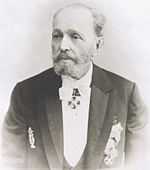Cinderella (Fitinhof-Schell)
| Ballets and revivals of Marius Petipa |
|---|

*Paquita (1847, *1881) |
Cinderella (aka Zolushka) is a ballet-féerie in three acts, with choreography by Enrico Cecchetti (Acts I and III) and Lev Ivanov (Act II), with the production being supervised under the counsel and instruction of Marius Petipa. Music is by Baron Boris Fitinhoff-Schell; the libretto is by Lidia Pashkova (ru: Лидия Александровна Пашкова) and Ivan Vsevolozhsky.
It was first presented by the Imperial Ballet on 17 December [O.S. 5 December] 1893 at the Imperial Mariinsky Theatre in St. Petersburg, Russian Empire. Principal dancers were Pierina Legnani (as Cinderella), Pavel Gerdt (as Prince Charming), Anna Johansson (as the Fairy Godmother/Good Fairy), Mathilde Kschessinskaya (as Odette, the stepsister), Maria Anderson (as Aloisa, the stepsister), Claudia Kulichevskaya (soloist in the Grand Pas d'action of Act II), Nikolai Aistov (as the King), and Alexei Bulgakov (as the Chamberlain).
Revivals
- Revival by Lev Ivanov for the Ballet of the Moscow Imperial Bolshoi Theatre. First presented on 31 July [O.S. 19 July] 1898.
- Revival of Act II by Lev Ivanov for the Imperial Ballet, and especially for the farewell benefit performance of Pierina Legnani. First presented on 5 February [O.S. 23 January] 1900 at the Imperial Mariinsky Theatre.
Notes
The famous variation in polka rhythm danced in the Mariinsky Theatre version of the "Le Corsaire Pas de Deux" is taken from Fitinhof-Schell's score for Cinderella.
Although the scenario of this work was greatly criticized by the St. Petersburg critics balletomanes for putting more emphasis on spectacle and dancing than on drama and story-telling, the production was still an enormous success, particularly with the début of the Italian ballerina Pierina Legnani, who according to one critic "swept all before her." The most celebrated scene was the ball in the Prince's castle in the second act, which included an elaborate Grand Pas d'action in the 19th century style for the characters Cinderella, the Prince, soloists, and the corps de ballet.
The premiere of this work in 1893 has the distinction of being the first performance of a ballet to ever have a ballerina perform 32 fouettés en tournant—by Pierina Legnani who danced the title role. The ballet historian Konstantin Skalkovsky, dance critic for the St. Petersburg Gazette during the latter half of the 19th century and early 20th century, reported on Legnani's feat: "in the last act Legnani positively outdid herself. When Emma Bessone danced the lead in "The Haarlem Tulip" she did 14 fouettés. In her variation Legnani performed 32 of them without stopping, and without traveling one inch! The public delightedly applauded the Ballerina and compelled her to repeat this variation as well. On the repetition she nevertheless did 28 fouettés. To count them became the favourite occupation of the public."
Gallery
-
Pierina Legnani in the title role of the Petipa/Ivanov/Cecchetti/Vietinghoff-Scheel Cinderella. St. Petersburg, 1893 -
Mariia Anderson as the fairy godmother in the Petipa/Ivanov/Cecchetti/Vietinghoff-Scheel Cinderella. St. Petersburg, 1893 -
Design by Matvey Shishkov for the ballroom scene of the Petipa/Ivanov/Cecchetti/Vietinghoff-Scheel Cinderella, St. Petersburg, 1893
| |||||||||||||||||||||||||||||||||||||||||||||||||||||||||||
| ||||||||||||||||||||||||||||



